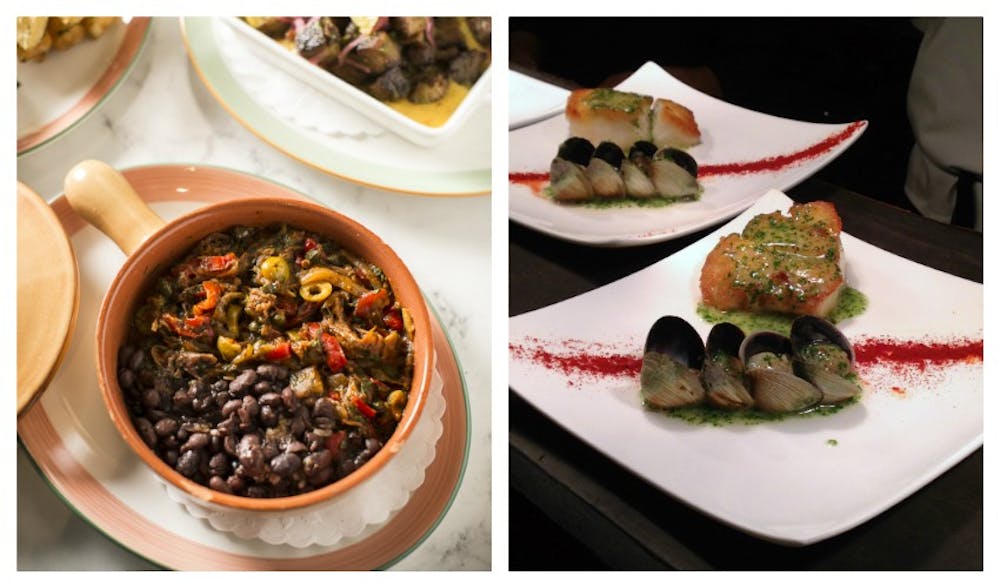
Philadelphia restaurants Rosa Blanca and Tinto participated in the semi-annual Restaurant Week.
Credit: Courtesy of Steve Legato and Tino respectivelyOn a typical Monday night, Penn students are gathered around tables in 1920 Commons or getting takeout from Chipotle for dinner. But, a few weeks out of the year, Penn students can be found trekking downtown to enjoy a full three-course meal at some of Center City’s finest restaurants.
In the last few years, Restaurant Week has become a crucial part of Philadelphia’s — and Penn’s — food culture. But while diners during Restaurant Week get the experience to try unique dishes and visit new restaurants, the week is just another day in the life for restaurant staff.
Dave Conn is the head chef at Tinto, a Garces Group Spanish tapas hotspot. Having been with the restaurant since its opening in 2007, Conn is no newcomer to Restaurant Week.
“I would have to double check how many years it’s been, but we’ve been doing it pretty much since our opening,” he said. “It’s definitely become a much bigger thing in the last four or five years,” he added.
Jose Olmeda, the chef de cuisine at the popular Cuban-style diner Rosa Blanca, doesn’t have as many years of experience with Restaurant Week, but he has found his footing nonetheless. Since helping to open the restaurant in December 2013, Olmeda has participated in every Restaurant Week in Philadelphia — three in total.
Across the city, Restaurant Week features different restaurants that offer a smaller tasting menu of some of their regular menu items at a more limited price point. Each restaurant offers a three-course dinner for a flat rate of $35 — at restaurants where dinner can often cost more than $50 per person. Many restaurants also feature a lunch menu, which offers three courses for a $20 price tag.
Participating restaurants and chefs are almost unlimited in fare or experience. Those participating this week range everywhere from the famous Stephen Starr Asian-fusion grill Buddakan to the Brazilian steakhouse Chima.
But while chefs come from all different backgrounds and experience levels, all restaurants participate for essentially the same reasons. While many times the decision to participate is made at the corporate level, the event gives restaurants highly valuable exposure.
“For us, it’s a no-brainer. Restaurant Week gives us a good level of exposure to a group of diners we don’t see on a regular basis,” Conn said. “It gives us a broader range of opportunity.”
And it seems to be working. According to Olmeda, diners start making reservations for Restaurant Week as much as a month in advance.
Conn agreed. “We definitely see people in higher volumes. We might get a lot of covers on a Friday or Saturday night typically, but during Restaurant Week, we’ll see as many covers on a Monday or Tuesday night,” he said.
With such a higher volume, juggling the restaurant and all the orders while maintaining the overall atmosphere and dining experience can be a challenge.
“It’s definitely a lot more fast-paced,” said Amanda Feinstein, beverage manager at Rosa Blanca. “You get a lot of people coming in, so we’re trying to move tables in and out as quickly as possible, but at the same time, people are there to enjoy the food, and we don’t want to sacrifice that,” she said.
And the food is really what Restaurant Week is about. While most participating restaurants feature relatively lengthy full menus, Restaurant Week menus often consist of nothing more than a few simple choices for each course. Deciding which dishes make the cut and which ones don’t can be a make-or-break moment for a restaurant.
“A lot of times we try to stick with our most popular dishes — and the ones that are typically favorited most by our staff,” Olmeda said.
Restaurant Week menu picks include masitas de puerco adobo, a spiced fried pork served with homemade corn pudding, and pollo a la brassa, rotisserie chicken accompanied by sour orange-achiote butter and roasted baby potatoes. “We did actually end up adding a new dish specifically for our Restaurant Week menu a year or so ago, and that was the vegetarian casserole because we didn’t really have a true vegetarian option, and it actually ended up on our regular menu,” he said.
Conn spoke specifically about a format — developed by Jose Garces himself — that guides the restaurant staff in deciding what will be on the Restaurant Week menu. “We always do three courses, and Jose Garces’ formula was always two savory courses and then a pastry — something sweet,” he said. As a tapas restaurant, each of the first two courses allows diners to choose not one but two menu items. “Some of them are more substantial and some are more classical tapas items, but we make sure Restaurant Week diners are exposed to a nice offering from the regular menu,” Conn said.
For Tinto, diners tend to gravitate toward duck confit wrapped in serrano ham smothered in a wild black cherry spread as well as the Spanish octopus with smoked green olive aioli and spicy tomatoes.
While many frequent Restaurant Week diners have complained that the week offers lowered standards of service and food, both Conn and Olmeda have done their best to make their Restaurant Week experience as consistent with their regular service as possible.
“A lot of thought goes into our menu when we’re picking things out to make sure that we’re able to execute the dishes with an increased volume without sacrificing the quality,” Conn said. “We really stand behind our offerings — nothing is being dumbed down just because the menu is more limited.”
Olmeda agreed, also emphasizing that while the menu was smaller, he didn’t want diners to feel restricted by it. “Our goal is to give customers a good idea of what would be on our regular menu, without it feeling limited,” he said.
Feinstein, who spends more of her time on the floor interacting with customers than behind the scenes in the kitchen, emphasized that Restaurant Week was about the entire dining experience, not just the food. “I like to be on the floor as much as possible, interacting with customers either at the hostess stand or at their tables. Our goal is to keep the quality of the experience the same, even with the higher traffic,” she said.
For many Penn students, Restaurant Week presents a more affordable way to experience some of the city’s best eateries.
“I went to Estia with some friends last week, and I had a great time. It wasn’t prohibitively expensive, and it’s probably not somewhere I would have gone without Restaurant Week,” College sophomore Robert Harrelson said.
“It’s not often that I get out of the lab and really enjoy the treats that the City of Brotherly Love has to offer. It’s really something special,” Wharton sophomore Jack Stein said.
As Restaurant Week winds to a close, for the restaurant staff, the week will be all about the victories.
“The staff works so hard during Restaurant Week. It’s pretty cool to see everyone moving together so quickly,” Feinstein said.
At Tinto, each Restaurant Week menu comes with five distinct plates of food. “One of the coolest things is looking back after the two-week period [of Restaurant Week] and seeing how many menus we sold and then multiplying that number by five. It’s just mind blowing. In that short amount of time, we have literally sold thousands and thousands of plates of food,” Conn said.
The Daily Pennsylvanian is an independent, student-run newspaper. Please consider making a donation to support the coverage that shapes the University. Your generosity ensures a future of strong journalism at Penn.
DonatePlease note All comments are eligible for publication in The Daily Pennsylvanian.







